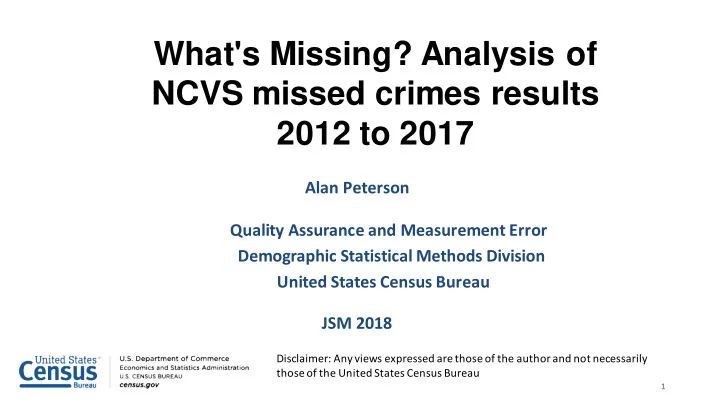

What's Missing? Analysis of NCVS missed crimes results 2012 to 2017 Alan Peterson Quality Assurance and Measurement Error Demographic Statistical Methods Division United States Census Bureau JSM 2018 re those of the authors and Disclaimer: Any views expressed are those of the author and not necessarily those of the United States Census Bureau 1 those of the U.S. Census Bureau. 1
NCVS Goal National Crime Victimization Survey (NCVS) – household survey conducted to provide national/subnational personal and property victimization crime rates Data gathered during interview includes: • Type of crime • Monetary loss/physical injury • Reported or not reported to police 2
Reinterview Reinterview (RI) is a second interview conducted at a household to determine if an interviewer actually conducted an interview and if the interviewer conducted it in accordance with established interview procedures. Goals of RI include… Overall: • Maintain the quality of survey data • Monitor Interviewer performance and adherence to procedures NCVS: • Re-ask crime screener questions to estimate missed crimes 3
Reinterview Sampling Methodology Random Reinterview involves selection of 3-4 percent of cases to check all interviewers over course of cycle. Interviewer experience is a stratification variable for sampling • Experienced vs inexperienced cutoff • Supervisors with > 2 months experience • Interviewers with > 5 years experience Experienced interviewers, all supervisors potentially selected for random RI once a year; • Inexperienced interviewers twice a year. • Select sample of cases (6 for experienced, 5 for inexperienced) 4
Missed Crimes Crimes not reported during NCVS interview then reported in NCVS RI. Missed crimes estimated using response to crime screener questions as a proxy for reported crimes. 5
Missed Crimes Measures Missed Crime Estimate • Weighted average of number of missed crimes by experienced and inexperienced interviewers. Households with Missed Crimes • Weighted average of number of households with missed crimes by experienced and inexperienced interviewers. 6
Missed Crimes Measures Proportion of Missed Crimes • Ratio of # of missed crimes (RI) to (number of crimes (original interview) + number of missed crimes (RI)) Proportion of Households with Missed Crimes • Ratio of households with missed crimes (RI) to number of households in original interview 7
Limitations Need both completed interview and reinterview Reinterview asks single person in household about person crimes not all persons Changes in reinterview instrument over timeframe 2012-2017 (content, data collection) 8
Evaluation Measures Missed crime measures over time (2012-2017) Missed crimes by interviewer experience Missed crimes by household characteristics 9
Missed crimes: 2012 - 2017 Missed Crimes and Households with Missed Crimes Percent of Crimes Households with Percent of Households with Year Missed Crimes Missing Missed Crimes Missed Crimes 2012 709.00 7.90% 513.29 7.99% (522.78, 895.21) (5.99%, 9.81%) (355.46, 671.12) (5.73%, 10.25%) 2013 1,021.63 12.41% 645.40 10.99% (777.61, 1,265.65) (9.82%, 15.01%) (453.59, 837.21) (8.08%, 13.90%) 2014 959.03 12.60% 638.63 11.79% (747.35, 1,170.71) (10.17%, 15.03%) (466.75, 810.51) (8.99%, 14.59%) 2015 716.86 8.65% 580.04 9.53% (527.69, 906.03) (6.57%, 10.74%) (413.84, 746.25) (7.06%, 12.00%) 2016 1,621.33 10.56% 1,150.87 10.58% (1,336.14, 1,906.52) (8.89%, 12.22%) (912.29, 1,389.46) (8.62%, 12.54%) 2017 976.10 7.75% 751.40 8.10% (742.87, 1,209.33) (6.04%, 9.46%) (547.99, 954.82) (6.09%, 10.12%) Source: United States Census Bureau 2012-2017 National Crime Victimization Survey (NCVS) Quality Control Reports 10
Missed crimes: 2012 - 2017 Missed Crime Estimates 2012-2017 2,000 1,621.3 1,600 Number of Missed Crimes 1,200 Missed 1,021.6 Crimes 976.1 959.0 716.9 709.0 800 Lower CL 400 Upper CL 0 2012 2013 2014 2015 2016 2017 Source: United States Census Bureau 2012-2017 National Crime Victimization Survey (NCVS) Quality Control Reports 11
Missed crimes: 2012 - 2017 Percent Missed Crimes 2012-2017 16% 14% 12.60% 12.41% Proportion of Missed Crimes Percent of 12% Crimes Missing 10.56% 10% 8.65% 7.90% Lower CL 7.75% 8% 6% Upper CL 4% 2% 0% 2012 2013 2014 2015 2016 2017 Source: United States Census Bureau 2012-2017 National Crime Victimization Survey (NCVS) Quality Control Reports 12
Interviewer Comparisons FR Experience Level Distribution 2012-17 Households with missed property/personal crimes 100% 90% 80% 70% 75% 70% 68% 68% 60% 50% 54% 53% 40% 30% 20% 10% 0% 2012 2013 2014 2015 2016 2017 (n=57) (n=53) (n=79) (n=57) (n=114) (n=92) Inexperienced Experienced Source: United States Census Bureau National Crime Victimization Survey (NCVS) Production and Reinterview Results Files 13
Household Comparisons Urban/Rural Distribution 2012-17 Households with missed property/personal crimes 100% 88% 86% 86% 80% 84% 83% 82% 60% 40% 20% 0% 2012 2013 2014 2015 2016 2017 (n=57) (n=53) (n=79) (n=57) (n=114) (n=92) Urban Rural Source: United States Census Bureau National Crime Victimization Survey (NCVS) Production and Reinterview Results Files 14
Household Comparisons Tenure Distribution 2012-17 Households with missed property/personal crimes 100% 43% 39% 34% 46% 38% 37% 90% 80% 70% 60% 64% 60% 59% 59% 56% 50% 53% 40% 30% 20% 10% 0% 2012 2013 2014 2015 2016 2017 (n=57) (n=53) (n=79) (n=57) (n=114) (n=92) Owned Rented No Cash Rent Source: United States Census Bureau National Crime Victimization Survey (NCVS) Production and Reinterview Results Files 15
Household Comparisons Household Income Distribution 2012-17 Households with missed property/personal crimes 100% 26% 25% 25% 25% 13% 18% 27% 80% 14% 15% 14% 23% 25% 17% 60% 12% 17% 11% 4% 9% 21% 23% 23% 21% 40% 21% 16% 29% 27% 26% 26% 20% 25% 23% 0% 2012 2013 2014 2015 2016 2017 (n=57) (n=53) (n=79) (n=57) (n=114) (n=92) Less than $25,000 $25,000 - $49,999 $50,000 - $74,999 $75,000 and over Refused Source: United States Census Bureau National Crime Victimization Survey (NCVS) Production and Reinterview Results Files 16
Conclusions Inexperienced FRs make up larger proportion of missed crime households in 2016 & 2017 than in prior years. Household tenure and Urban/Rural breakdowns of missed crime households appear consistent over time. Household income distributions of missed crime households vary across timeframe. Still consistent when collapsing income categories. 17
Alan Peterson Quality Assurance and Measurement Error Demographic Statistical Methods Division U.S. Census Bureau alan.k.peterson@census.gov 18
Recommend
More recommend